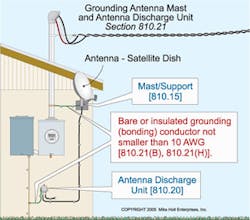All questions and answers are based on the 2005 NEC.
Q. Can I ground a satellite system to the metal parts of electrical equipment?
A. No. You must ground the antenna mast [810.15] and antenna discharge unit [810.20(C)] to one of the following, as shown in the Figure:
-
Building or structure grounding electrode system [250.50].
-
Interior metal water piping system, within 5 feet from its point of entrance [250.52(A)(1)].
-
Accessible means external to the building, as covered in 250.94.
-
Metallic service raceway.
-
Service equipment enclosure.
-
Grounding electrode conductor or the grounding electrode conductor metal enclosure.
Grounding the lead-in antenna cables and the mast helps prevent voltage surges caused by static discharge or nearby lightning strikes from reaching the center conductor of the lead-in coaxial cable. Nothing can prevent damage from a direct lightning strike, but grounding with proper surge protection can help reduce damage to satellite and other equipment from nearby lightning strikes.
Q. How deep must I bury USE cable?
A. When cables or raceways are run underground, they must have a minimum “cover” in accordance with Table 300.5. Note 1 to Table 300.5 defines “cover” as the distance from the top of the underground cable or raceway to the surface of finish grade. According to this table, Type USE cable must have 24 inches of cover, unless the installation is a residential 15A or 20A branch circuit rated 120V or less with GFCI protection.
Q. Can I install low-voltage, Class 2 thermostat wire in the same raceway with power conductors for the A/C compressor?
A. No. As specified in 725.55, Class 2 cables are not permitted to be placed in any enclosure, raceway, or cable with conductors of electric light or power.
However, Exception No. 2 to 725.52 allows Class 2 circuits to be reclassified as a Class 1 circuit if the Class 2 equipment markings are eliminated — and the circuit is installed in a Chapter 3 wiring method [725.55(D)(2)(b)]. Reclassifying the circuit allows the Class 1 circuit to be installed with functionally associated power circuits in accordance with 725.26(B)(1).
Q. Can Type MC Cable be installed in a cable tray?
A. Yes. See Table 392.3(A).
Q. Can I use a cable tray in a commercial occupancy?
A. Yes. Cable tray installations aren't limited to industrial establishments [392.3].
Q. Can nonmetallic raceways be installed under the raised floor of a computer room?
A. Yes. You must install branch-circuit supply conductors for information technology equipment under a raised floor in accordance with the requirements contained in Art. 645 — not Art. 300 [300.22(D)]. Sec. 645.5(D)(2) permits you to install the following nonmetallic wiring methods under raised floors of information technology equipment rooms: rigid nonmetallic conduit, electrical nonmetallic tubing, nonmetallic wireway, nonmetallic surface raceway, liquidtight flexible metal conduit, or liquidtight flexible nonmetallic conduit.
Q. Must I secure wiring installed under the raised floor of a computer room?
A. Any wiring method field installed in the underfloor space of information technology equipment rooms must be securely fastened in place in accordance with 300.11 [645.5(D)(2)]. However, power cables, communications cables, connecting cables, interconnecting cables, and associated boxes, connectors, plugs, and receptacles that are listed as part of (or for) information technology equipment shall not be required to be secured in place [645.5(D), 645.5(E)].
Q. What are the grounding requirements for the metal standards that support a raised floor system in computer room?
A. There are none.
Q. Does the NEC allow me to mix intercom system conductors (audio circuits) and power circuit conductors in the same raceway?
A. This depends on the rating of the audio conductors. For example, audio output circuits [640.9(C)] using Class 2 or Class 3 wiring methods [725.54 and 725.61] are not permitted in any enclosure, raceway, or cable with conductors of electric light or power circuits. However, you can mix audio output circuits using Class 1 wiring methods [725.25] with power circuits where the two systems are functionally associated with each other [725.26(B)(1)].
The concern is that a fault from audio amplifier circuits to Class 2 and Class 3 circuits has the potential of creating a hazard by disrupting the operation of alarm systems and remote-control circuits for safety control equipment.
Q. I'm working on a house with a detached garage for aircraft. Are there any special rules I need to know about?
A. Yes. Article 513 has a number of stringent requirements for buildings or structures in which aircraft might undergo service, repairs, or alterations.
Q. Can I use NM cable to wire a hot tub? What about a hydromassage bathtub?
A. Outdoor hot tub motors must be installed in rigid metal conduit, intermediate metal conduit, rigid nonmetallic conduit, or Type MC cable listed for the location (sunlight-resistant or for direct burial) [680.21(A)]. Indoor installations of hot tubs can be connected by any of the wiring methods contained in Chapter 3 [680.43]. Hydromassage tubs also are allowed to be installed by using any of the Chapter 3 wiring methods.
About the Author

Mike Holt
Mike Holt is the owner of Mike Holt Enterprises (www.MikeHolt.com), one of the largest electrical publishers in the United States. He earned a master's degree in the Business Administration Program (MBA) from the University of Miami. He earned his reputation as a National Electrical Code (NEC) expert by working his way up through the electrical trade. Formally a construction editor for two different trade publications, Mike started his career as an apprentice electrician and eventually became a master electrician, an electrical inspector, a contractor, and an educator. Mike has taught more than 1,000 classes on 30 different electrical-related subjects — ranging from alarm installations to exam preparation and voltage drop calculations. He continues to produce seminars, videos, books, and online training for the trade as well as contribute monthly Code content to EC&M magazine.
